Of course, you can’t have it if you’re in Libya, North Korea, New York, New Jersey or Massachusetts because it’s a big assault Johnson, but what it is, is a rare Johnson LMG kit, restored onto a semi Johnson M1941 rifle receiver, producing a legal semi-auto Johnson LMG. And you can have it — if you win the auction.
Manufactured on the original Johnson 1941 semi auto receiver , using original US GI LMG parts , semi auto only . Excellent condition , park. military finish ,mint original barrel , beautiful wood furniture. Test fired only. The gun fires , extracts and reloads 100% , very accurate. The gun comes with bipod and 3 magazines. Shipping to an FFL or C&R holder. The gun will be shipped from FFL in PA.
via 1941 Johnson LMG light machine gun semi m1941 : Semi Auto Rifles at GunBroker.com.
There are a number of these around. By “a number,” though, we’re probably talking about a single digit number. The parts kits are rare, and the rifles are valuable enough to collectors that it’s hard to make the case for sacrificing one.
Johnson guns get their collector cachet from their rarity1 and their use in training and combat by elite elements including the Paramarines, the Marine Raiders, the Canadian-American First Special Service Force (all ephemeral, hostilities-only WWII units), the OSS, and Brigada 2506, the Bay of Pigs invaders. The Marines and Cubanos only used the rifles; the FSSF, only the machine guns. Any surviving Johnson has some part of this history.
Because the Johnsons were not standard arms with standard doctrinal spare parts and maintenance support, they were withdrawn and replaced with US standard rifles and auto rifles/LMGs. Carefully packed away, all of them except for probable OSS/CIA stocks were surplused after the war.
We don’t know what it will go for. The current bid in the $8k neighborhood has not met the reserve (the rifles sell for $4k and up). Some comments, and the rest of the photos, after the jump.
Notes
- 30,000 Johnson M1941 rifles were made, a large percentage of which survive, but only about 3,000 were machine guns according to ATF Form 2s filed by Johnson Automatics. The Johnson M1944 machine gun appears to have been produced only in prototype quantities.
The Johnson in More Depth
One of the more remarkable things about the Johnson LMG is the superficial similarity it has to the German FG.42. Internally, they’re radically different, with the American gun using the short-recoil principle, and its German counterpart relying on gas operation. Both had a turning bolt, but while the FG.42 had a conventional dual-lug design, derived from its ancestor, the Lewis gun, the Johnson had a revolutionary, patented multi-lug bolt that is the forerunner of the AR bolt design.
FG-42 features that are duplicated on the Johnson include the bipod, the high sight line and folding rear sight (although the FG has folding sights at both ends), the pistol grip and straight-line stock, and the left-mounted magazine and right-ejection layout. Both were chambered for full-power combat cartridges. These similarities result directly from the design requirement for a light, highly portable automatic weapon for airborne and light infantry forces.
Places where the designs diverge include the magazine: the FG-42 had what is now a conventional twin-row 20-round detachable box magazine, and the Johnson used an evolutionary dead end, a single-row 30-round magazine. It is a rare example of a WWII combat weapon that used a single-row magazine.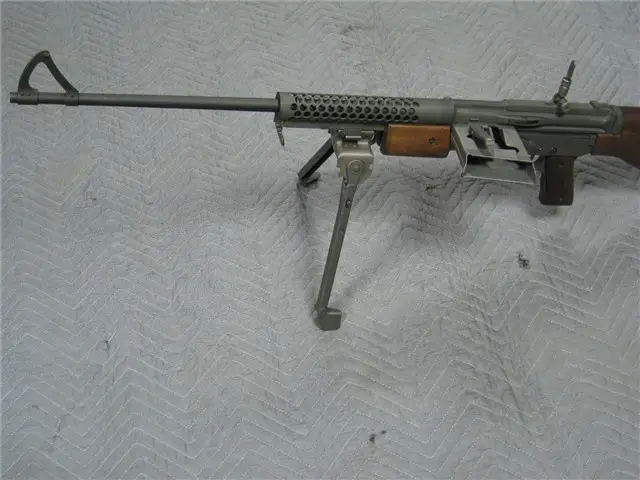
Both guns were originally built with a forged steel receiver, but with extensive cost- and machine-time-saving measures taken in the design. The Johnson could be built more rapidly and economically than the Garand, despite the Garand’s 15-year head start on production design.
Tests in 1940 and 1941 sometimes found the Johnson rifle slightly superior, sometimes the Garand. Since the Garand was in full production, the Johnson would have had to be enormously superior to warrant a change on the brink of war. It is possible, though, that General Holcomb, the Commandant of the Marine Corps, used the threat of adopting the Johnson to “encourage” General Wesson of Army Ordnance to prioritize equipping USMC formations more highly than an Army officer might otherwise do. (Read between the lines of this letter and tell us what you think). 
The Johnson LMG would have been a natural purchase for a Johnson Rifle-equipped service. But even as a stand-alone product, the Johnson LMG had real advantages over the standard US equivalent, the Browning Automatic Rifle M1918A2. It was handier and had a larger magazine and a straight-line recoil layout. But it never was purchased. Instead, the leftover Dutch East Indies machine guns showed up all over the US’s supported special operations theaters. 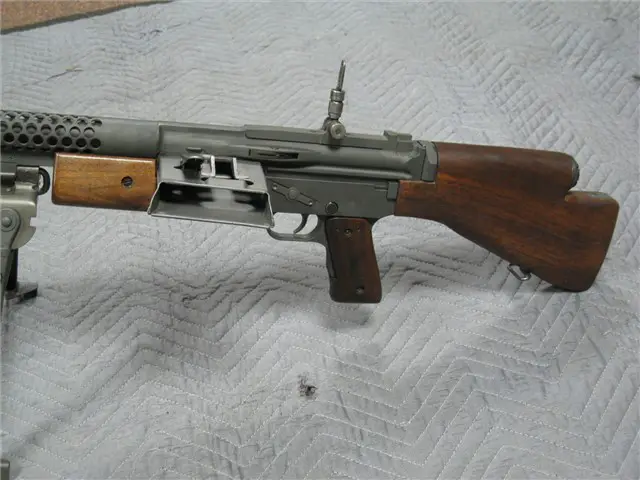
Johnsons in good condition are not rare, although both Johnson machine guns, and semi-auto builds on Johnson kits are. 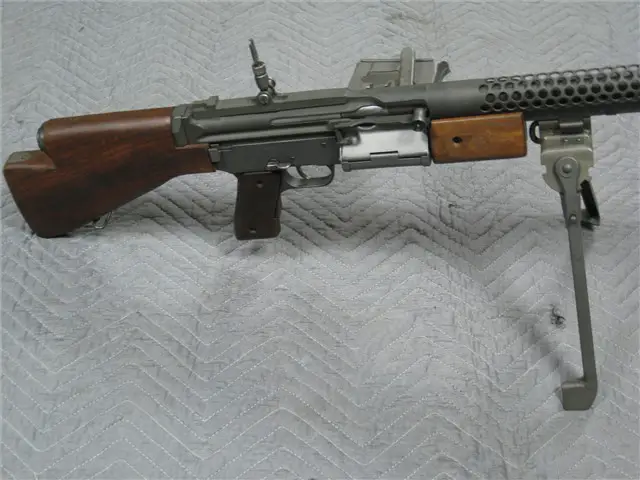
Some lucky bidder may take home this remarkable history lesson on two legs. 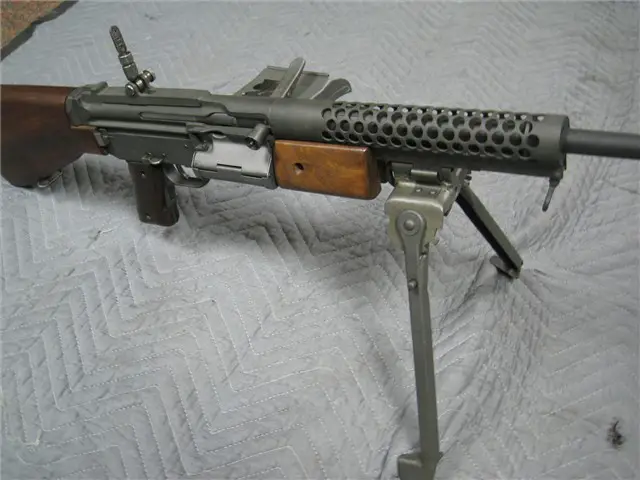 As with the rifle, the barrel of the MG is readily removable. This was not done to facilitate barrel changing in the field, as no spare barrels were issued. But any paratroops that had to jump a machine gun appreciated the chance to break it down but still quickly get it into action on landing.
As with the rifle, the barrel of the MG is readily removable. This was not done to facilitate barrel changing in the field, as no spare barrels were issued. But any paratroops that had to jump a machine gun appreciated the chance to break it down but still quickly get it into action on landing.
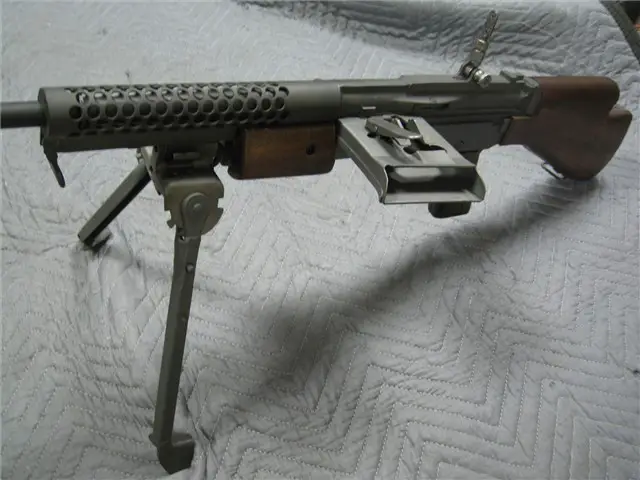
Johnsons are fun to shoot, but then, so is a Garand or BAR. The Johnson guns are a little eccentric and out of the mainstream. On the range, you either get, “Wow! A Johnson!” or, “What the hell is that?”
When the Army replaced the BAR, they didn’t go with the light, capable Johnson but instead pushed the enormous M1919 Browning machine gun down to squad level, with a grafted-on shoulder stock and a bipod that was designed by someone who must never have been a grunt. One reason Johnson’s rifle and machine gun were a technical, if not commercial, success is that Mel Johnson was a Marine officer, and even though he was an ordnance officer he never lost touch with what the rifleman needed.
You seldom see the dorsal (overhead) view of the Johnson LMG: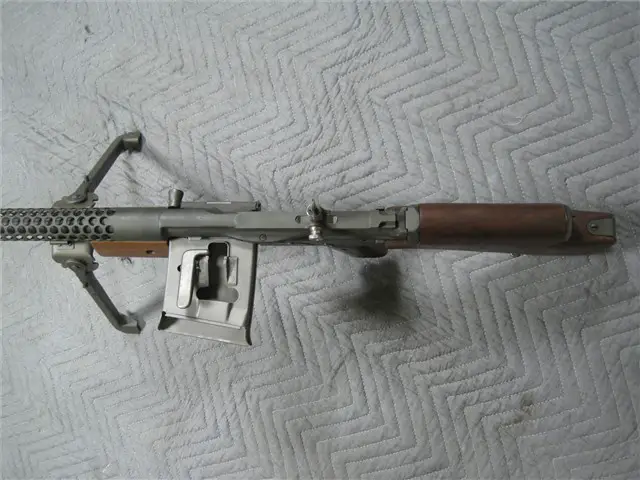
And hardly ever, the ventral aspect of the same rifle:
The barrel catch is forward of the bipod attachment. It’s actuated by pressing it with the tip of a round of ammunition.
Now, even if you already have one Johnson, don’t you want a bigger one?
Update
The auction has concluded. It was a No Sale — reserve not met at a high bid of $8,250. It’s listed again, now with a starting bid of $7,500 and an unknown (but almost certainly > $8,250) reserve.

Kevin was a former Special Forces weapons man (MOS 18B, before the 18 series, 11B with Skill Qualification Indicator of S). His focus was on weapons: their history, effects and employment. He started WeaponsMan.com in 2011 and operated it until he passed away in 2017. His work is being preserved here at the request of his family.

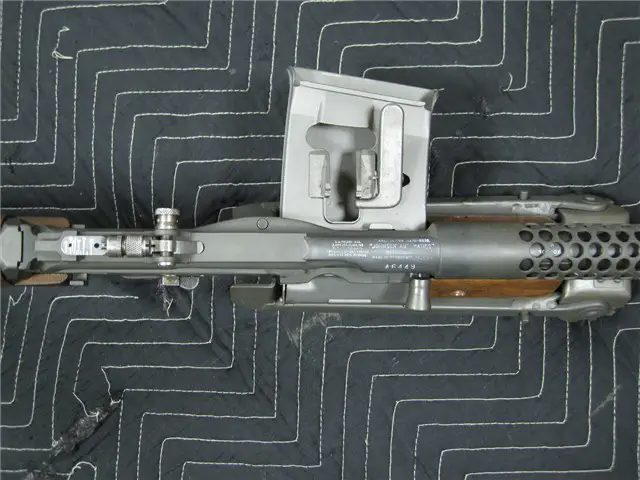
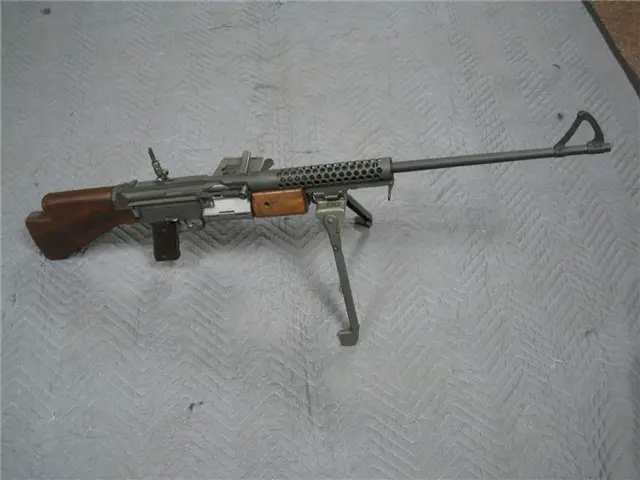
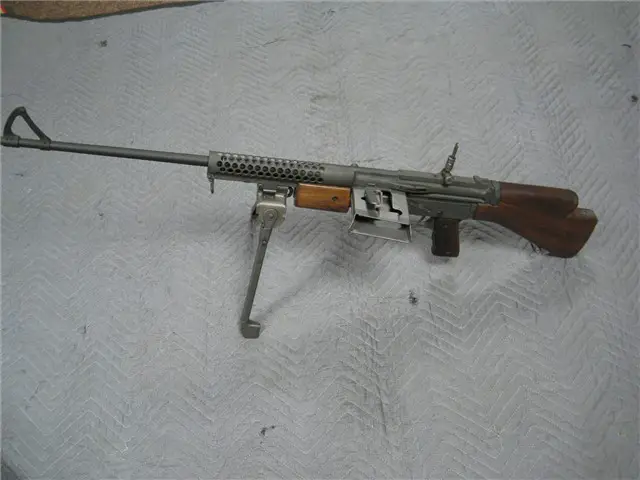
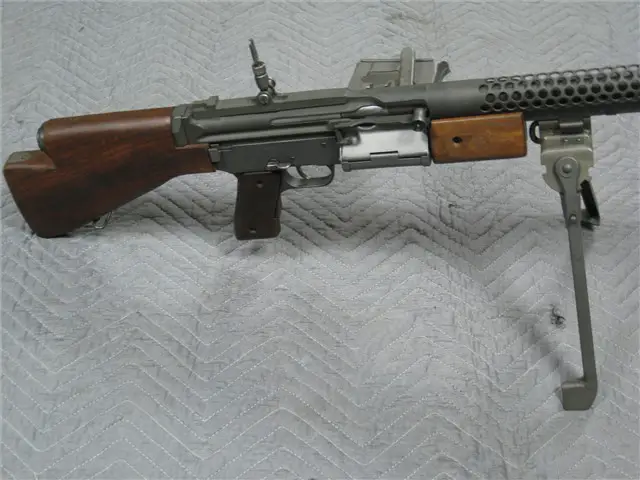
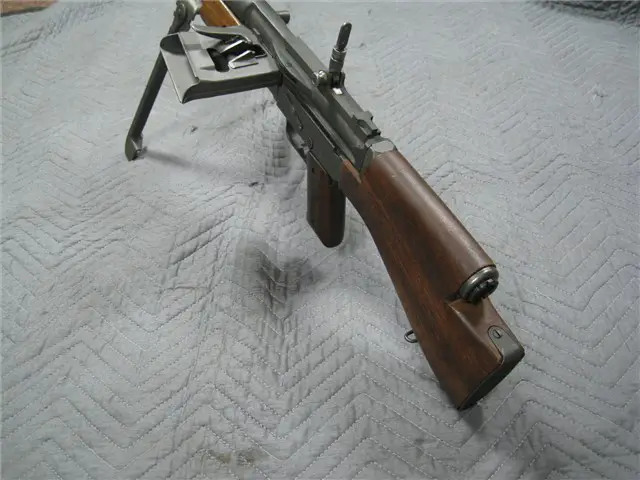
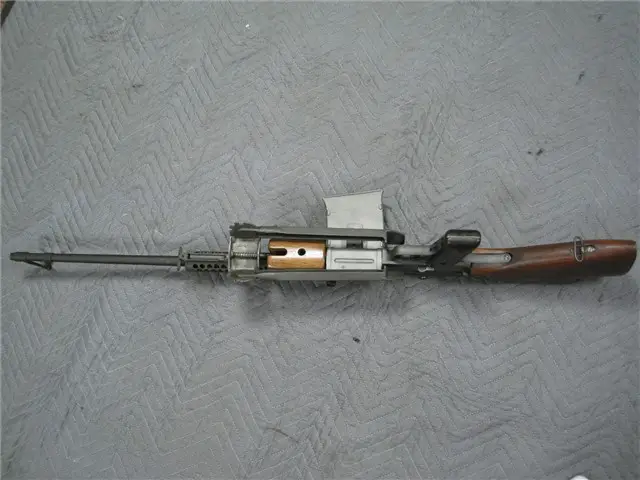
21 thoughts on “Someone’s Flogging His Big Johnson”
“Of course, you can’t have it if you’re in Libya, North Korea, New York, New Jersey or Massachusetts…”
Are you kidding me? That has to be the most dangerous looking pistol grip I have ever seen in my life. Thank god they have banned such things in NY and we don’t have to worry about anyone breaking into the house here weilding that thing.
The only possible way that could be made more dangerous than it already is, would be if they added a bayonet lug to it. That would be totally insane.
Yeah, I mean without one how can I give my enemies the cold steel?
On a serious note, I gotta comment on those sights. Why so high off axis? They also don’t seem like they would be great for automatic fire.
A straight-line stock commits you to high sights, whether on an AR, a Johnson LMG, an EM-2, or an FG.
***A straight-line stock commits you to high sights,***
Or offset ones, like those on the Bren, Fremch Mle 24/29, Jap type 99, and others with top-mounted magazines. Which, in this day of electro/optical sights does offer one certain possibility: iron sights on one side, glass on the other.
The rifle has a bayonet lug, but it is without the scary pistol grip and terrifying 30-round detachable mag. It has a 10-round fixed mag. Not sure if that’s SAFE Act legal. Maybe if you only put in 7 cartridges or something.
Hah, shame on me for not reading the post!
Fixed mag means this is not an assault rifle, guaranteed. (this is not a guarantee).
So with that, then this thing would be a-ok in NY, pistol grip and all.
No, the MG in this picture uses a 30-round detachable mag. Of course you could fit one of the rifle nondetachable 10-round rotary mags to it instead. They load through strippers like a Springfield or Mauser (because a Springfield, duh, is a Mauser. Just an unauthorized copy). I think one Marine officer actually had a Johnson set up like that, with the MG stock, sights and pistol grip, and the rifle mag, that he acquired in some kind of dope deal with Mel Johnson. It’s in the book, anyway.
***No, the MG in this picture uses a 30-round detachable mag***
All of the Johnny guns I’ve played with have 20-round mags. If anyone needs any, I’ve got a good source, at around $20 per.
The Israeli *Dror* AR/LMG developed by the Israelis in trhe late ’40’s-early ’50s oweed a lot to the Johnson, and the first-version model used 30-round Bren magazines fed from the side; Later 7,92mm versions used 20-round BAR mags fed from underneath. That may be what caused the confusion.
I forget where I read it but I heard that one of the issues that came up in testing the Johnson was that the recoil movement could be interrupted it something rested against the barrel. That and weight of a bayonet (hence the small spike one developed for it). That and the single stack MG mags having to be carried in a shoulder bag since no pouches were developed.
Matt
Far more interesting to own than a grease gun or an M1 carbine, unless it had some spectacular provenance. I saw a paratrooper carbine at auction once that had documents going back to D+3, where an engineer captain (later colonel) picked his weapon up from a dead paratrooper and carried it until VE day.
Anyhow, the Johnson guns are very cool, and I wish I could own one.
Please keep the Johnson posts coming, just for the grins provided by the most excellent titles. 🙂
I see what you did there.
Something tells me the Libyans don’t really care right now, and would probably be more upset by someone showing up with only one weapon for 8k+.
Why a single -mag? Easier/cheaper todo produce? Also, had the LMG being able todo use the existing BAR magos would hace been a great bost to commonality (but maybe that was a dirty word back then?)
Ok, I’ll try again with a proper keypad, pléyade disregard, or erase, the previous post:
I was wondering why a single-row mag. Was it easier/cheaper to produce? Using, or being cable to use, existing BAR mags would have been a huge bost in commonality (but maybe that was a dirty word back in the 40’s?)
Johnson had a “thing” about dual-feed magazines, having had some really bad experiences with using them in other designs. You have to remember, this was the first half of the 20th Century, and a lot of things we take for granted, like reliable magazines, just weren’t that well figured-out. Which is why Johnson opted for a single-column, single-feed magazine. It’s kind of ironic, because while he was doing that, they got reliable magazines into production in large lots…
People really don’t comprehend how hard it was to do “little” things like that, back in the day. Tolerances stack, and the precision of manufacture we’re used to isn’t something that just “happened”. I’ve got a book, somewhere, where a post-WWI NCO discusses having to go through cases of early BAR magazines to hand-select ones that would feed reliably enough for a demonstration he was putting on at the Infantry School. Out of around a hundred magazines, he found 20 or so that he thought were reliable enough to use…
Which is partially why Johnson used the “odd” magazine for his auto-rifle, and why he built the ten-round rotary one into the rifle.
Yes, true. Didn’t look at it that way… The Chaucat and the Lewis come to mind when speaking of delicate LMG feeding systems with bad reliability. But I thought the issue was somewhat fixed by the late 30s precisely by retorting to box magazines (the ZB vz 26 comes to mind, the Astra-Unión M1927…). Guess also Johnson never intended his creation to coexist with the BAR, but altogether replacing it so designing a new, more reliable mag made perfect sense.
***I was wondering why a single-row mag. Was it easier/cheaper to produce? ***
Mel Johnson was a reserve USMC Colonel, and in the early days of the war and just before, the M1 Garand was less well developed than it was after the first half-million or so had been produced; that was one reason the Marines wanted to hedge their bets with the Johnson rifle design. But until the rifle situation was straightened out, the Marines stuck with their beloved ’03 Springfields and the 5-shot charger *stripper clip* which fed it…and which also worked [two of ’em!] to top up the magazine of the Johnson rifle. Accordingly, COL Johnson also arranged the 20-round magazine of his autorifle [M1941 version] to be reloaded with 5-shot Springfield clips. And that’s a little easier to do with a single row feed magazine. .
***Using, or being cable to use, existing BAR mags would have been a huge bost in commonality (but maybe that was a dirty word back in the 40’s?) ***
I think the idea was for the *new weapon* to be able to present an advance or improvement over the old ones. Along the same lines I always wondered why the M3 [and later M3A1] grease guns didn’t use the very nice 30-round Thompson SMG magazine rather than the oversize and stoppage-prone .45 copy of the Sten magazine the design was saddled with. My guess? When Army Ordnance handed some assorted Stens, Gimpel MP38s, and a PPSh or two to the Guide Lamp engineering department of GM and said *we need something like this, only stamped out and meant for production using existing automotive industry methods* they included the magazine. So the new gun design had a Sten-copy magazine, only bumped up to .45 M1911 dimensions.
don’t you want a bigger one?
This is the one case where I answer in the affirmative.
See the March, 1957 Guns magazine. An AR10 is on the cover.
http://www.gunsmagazine.com/1957issues/G0357.pdf
Page 12 of the free download.
My Favorite gun
By MELVIN MAYNARD JOHNSON Engineer and gun designer
After many years “Emma”, the Johnson Model 1941 light machine gun, is still my favorite gun. If I were to put Emma on the trail again now, new and lighter alloys, light plastics, and the light .308 Winchester
(7.62 mm NATO) could be used in her. Emma today could weigh eight pounds, instead of twelve.
During operations in Italy, members of the First Special Service Force loaded Emma with 26 rounds, fired eight semi-automatic, then switched to full automatic. ‘Germans. thinking the first shots were from an Ml
rifle, would attack, hoping to catch the rifleman in the process of reloading, only to be met with a 17-shot full-automatic burst. It was a highly effective piece of deception which endeared Emma to her users if not to her enemies.
The Marine Corps Gazette online archive has an November, 1950 article by Melvin Johnson, Marine Weapons: From Musket To M-1. Sadly, the download is not free, but the cost is reasonable. Sorry, don’t remember how much. I picked up the Melvin Johnson article to round out the 4/1 price to go with Jeff Cooper’s first pistol article.
As a gun-struck kid I got to shoot a Johnson ’06 rifle way back when. “Imagine my surprise” when a Johnson LMG showed up at a MG shoot out here in flyover country a few years back. I got to put a full mag through it, offhand, which was fun. Quite a handful though, even in short bursts.
Johnson’s wartime book, “Practical Marksmanship, A Guide to Field Firing”, is still a good read, if dated.